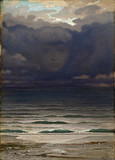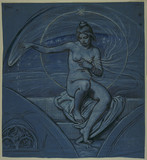During the second half of the nineteenth century Elihu Vedder was among the most imaginative and independent of the American expatriate artists. After studying with the genre painter Tompkins H. Matteson (1813-1884) in Sherburne, New York, Vedder traveled to Paris, where in 1856 he drew from casts in the atelier of François-Edouard Picot (1786-1868). In 1857 he moved to Florence to study with Raffaello Bonaiuti (active mid, nineteenth century). While in Florence he also became associated with the Macchiaioli, a group of experimental Italian plein-air painters, and influenced by them, he painted light-filled landscapes and views of rustic towns.
Vedder returned to the United States in 1860 and began to establish a reputation for imaginative literary paintings and book illustrations. He became a member of the Tile Club and the Century Association and an intimate of notable artistic and literary circles in New York. In 1863 he was elected an associate of the National Academy of Design. He visited Brittany with WILLIAM MORRIS HUNT and Charles Caryl Coleman (1840-1928) in 1866 and then settled in Rome, becoming a well-known expatriate figure. In 1869 he visited London, where he established important associations with Pre-Raphaelite artists as a result of his friendship with Frederic Leighton (1830-1896) in Florence. During much of his career he continued to paint Italian landscapes and costumed figure pieces, but by the 1870s he became increasingly philosophical, using personal, symbolic imagery--sometimes derived from literature, religion, or myth--to explore questions of faith and mortality.
In 1881 Vedder won the Prang Christmas card competition, inaugurating his active participation in the field of decorative arts. He soon became a sought-after designer of stained-glass windows, book illustrations, and murals, receiving commissions for murals from major architects and assignments from leading journals. His most important murals were for the home of Collis P. Huntington, 1892-93 (now Yale University Art Gallery, New Haven, Connecticut), the Walker Art Building at Bowdoin College, Brunswick, Maine, 1895-1900, and mosaics for the Library of Congress, Washington, D.C., 1897; his most famous illustrations were for the Rubáiyát of Omar Khayyám, 1884.
In the early 1890s he built a villa on the island of Capri, where he resided for the rest of his life, but he continued to make frequent visits to the United States until 1901. After the death of his wife, Carrie Rosekrans, in 1909 he began writing poetry, and some of his writings were published as Miscellaneous Moods in Verse (1914) and Doubt and Other Things (1923).
BIBLIOGRAPHY
Archiv. Am. Art and New York, American Academy of Arts and Letters, Elihu Vedder Papers, all on microfilm at Archiv. Am. Art § Elihu Vedder, The Digressions of V. (Boston: Houghton Mifflin, 1910), with appendix of chronological list of sales § Regina Soria, Elihu Vedder: American Visionary Artist in Rome (1836-1923) (Rutherford, NJ.: Fairleigh Dickinson University Press, 1970), with catalogue raisonné, bibliography § Marjorie Reich, "The Imagination of Elihu Vedder As Revealed in His Book Illustrations," American Art Journal 6 (May 1974): 39-53 § Washington, D.C., Smithsonian Institution, National Collection of Fine Arts, and Brooklyn Museum, Perceptions and Evocations: The Art of Elihu Vedder, exh. cat., 1979, published by Smithsonian Institution Press, with introduction by Regina Soria, essays by Joshua C. Taylor, Jane Dillenberger, and Richard Murray, bibliography.



